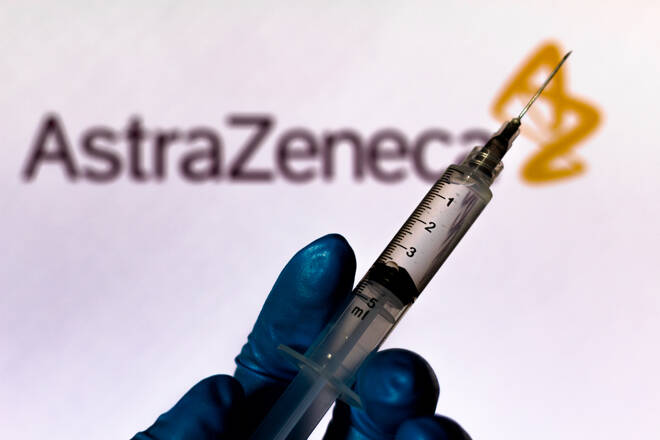Advertisement
Advertisement
COVID-19 Vaccine Update – AstraZeneca Releases Trial Results
By:
AstraZeneca and the University of Oxford fail to impress the markets with phase 3 trial results. Logistics and production could favor their vaccine, however.
In this article:
AstraZeneca and the University of Oxford
Following impressive phase 3 clinical trial results from Pfizer Inc. and Moderna Inc., AstraZeneca was in the spotlight today.
AstraZeneca and the University of Oxford released phase 3 clinical trial results today.
According to today’s press release:
- Two dosing regimens were used in clinical trials carried out in the UK and Brazil.
- One dosing regimen (n=2,741) showed vaccine efficacy of 90% when AZD1222 was given as a half dose and then followed by a full dose at least one month apart.
- The second dosing regimen (n=8,895) showed 62% efficacy when given as two full doses at least one month apart.
- Combining both dosing regimens, the trials delivered an efficacy rate of 70%.
- Importantly, there were no reported hospitalizations or severe cases of the disease.
While the clinical trial results were less impressive than those of Pfizer Inc. and Moderna Inc., AstraZeneca does have an edge.
The vaccine does not require similar refrigerated temperatures as those of Pfizer Inc. and Moderna Inc.
Combined with the group’s non-profit pledge, lower transportation costs will likely make the vaccine more accessible to developing economies.
As we had previously reported, AstraZeneca has already commenced the manufacturing of the vaccine in Australia. The decision to begin manufacturing before any clinical trials came in response to Pfizer Inc.’s first set of results.
The Latest COVID-19 Numbers
At the time of writing, the total number of COVID-19 cases worldwide stood at 59,078,540. The U.S alone accounted for 12,589,088 cases, with India accounting for 9,140,312.
Looking at the most affected EU member states, France, Spain, Italy, and Germany had a combined total of 6,070,406 cases. Back in mid-September, the 4 member states had a combined total of just 829,289 COVID-19 cases.
When you include the UK’s 1,512,045 total cases and consider the rest of the EU, the numbers aren’t too dissimilar to that of the U.S.
Both have faced similar issues as a result of allowing freedom of movement inter-state and across borders.
Containment measures are back in effect, however. Even the U.S administration has handed the reins to each state to manage the COVID-19 pandemic.
With winter now upon both the U.S and Europe, a vaccine cannot come fast enough.
Looking Ahead
For now, Pfizer Inc. and BioNTech look to remain ahead in the race to deliver a vaccine. The FDA is reportedly scheduled to review Pfizer Inc.’s EUA submission next month. By that time, Moderna Inc. will have also likely made its submission.
From the weekend, there were reports that Pfizer Inc. would be able to begin delivering the vaccine just days later.
While that is certainly positive news, a more worldwide inoculation would likely take longer, however.
That would mean that border restrictions globally would not come to an end as soon as the vaccine is available in the U.S.
While governments have placed their orders with the front runners, the rate of production will become a key consideration.
This may give AstraZeneca an edge going into the New Year. Much will depend on output numbers, however, and whether there are any manufacturing issues faced by the leading pharmas.
The race has, therefore, heated up and the likes of Johnson & Johnson, Medicago, Novavax, and Sanofi are facing a widening gap… Failure to deliver phase 3 clinical trials by the end of the year could leave the task of a global inoculation in the hands of the 3 front runners.
The Market Reaction
At the time of writing, AstraZeneca’s share price was down by 1.56% to £8,187.00. By contrast, however, riskier assets found support on expectations of an available vaccine by mid-December.
The weaker efficacy rates than those of Pfizer Inc. and Moderna Inc. contributed to the pullback.
While the efficacy rates are lower, AstraZeneca could enjoy a wider distribution network. As previously mentioned, the vaccine can be transported at higher temperatures that reduce transportation costs.
For investors, however, the non-profit pledge does offset the effect of the likely lower transportation costs on the bottom line.
With a number of major players trailing the front runners at present, any positive reports from the likes of Novavax would be well received.
Novavax is developing a vaccine that can be transported at temperatures of between 35F and 46F. This could become a deciding factor once the winter has passed. Phase 3 clinical trials are due out in the 1st quarter of next year.
About the Author
Bob Masonauthor
With over 20 years of experience in the finance industry, Bob has been managing regional teams across Europe and Asia and focusing on analytics across both corporate and financial institutions. Currently he is covering developments relating to the financial markets, including currencies, commodities, alternative asset classes, and global equities.
Latest news and analysis
Advertisement
